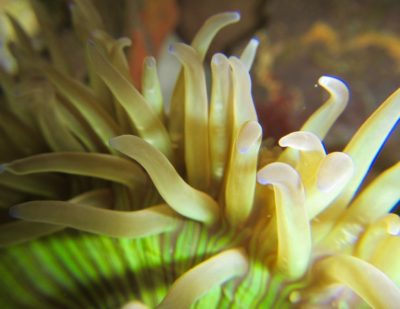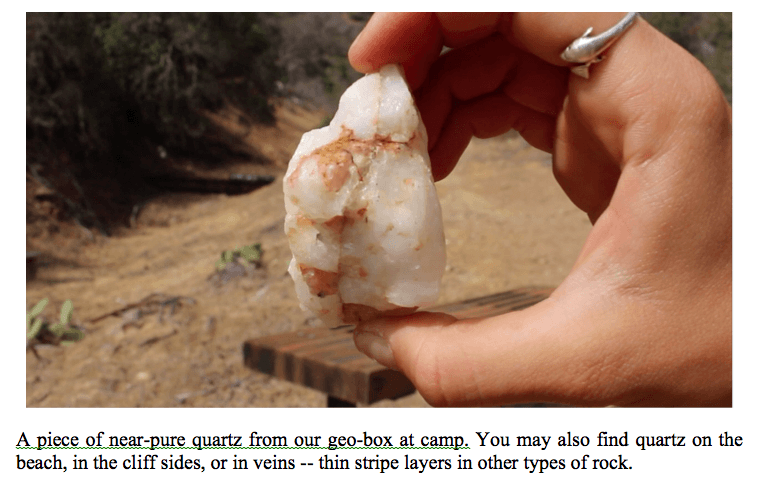
Ever picked up a glittering rock and wondered how those beautiful crystals form? Here on Catalina we have lots of shiny igneous rock, and some metamorphic and sedimentary rock with crystal (igneous) elements. Any time you see smooth, reflective rock, think about the enormous temperatures and pressures it took to cook it up!
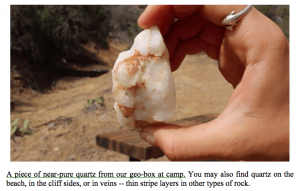
A hundred million years ago, the Pacific Oceanic tectonic plate, made largely of dense basalt, subducted under the North American continental tectonic plate, made of lighter granite. Like oil floating on top of water, that which was heavier or more dense (the basalt) sunk beneath what was less dense (the granite). Magma oozed up from the lithosphere, the zone directly under the Earth’s crust. Rock types rich in magnesium and iron, called mafic rock, and rock types made of lighter elements, such as silicon, aluminum, and oxygen, called felsic, melted at extremely high temperatures and pressures in the subduction zone.
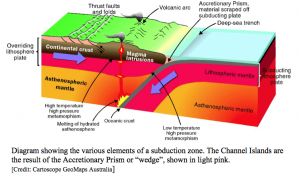 In the next 80 million years after the islands began to form, the tectonic plates continued to settle and shift, and 20 million years ago, an intense period of volcanism around the Channel Islands created even more igneous intrusive rock.
In the next 80 million years after the islands began to form, the tectonic plates continued to settle and shift, and 20 million years ago, an intense period of volcanism around the Channel Islands created even more igneous intrusive rock.
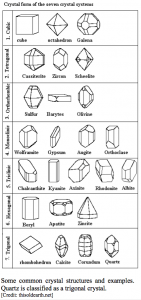 When magma cools slowly underground, intrusive igneous rock is formed. Extrusive rock, by contrast, forms when magma reaches the surface and cools quickly as lava. Trapped underground, that melted rock cooled slowly, allowing molecules to move past each other until they found another of the same shape to which to stick, forming crystals. The molecular properties of the elements involved will determine what shape the crystals form. One such example is quartz, made of silica and oxygen molecules stuck together in an ordered trigonal pattern.
When magma cools slowly underground, intrusive igneous rock is formed. Extrusive rock, by contrast, forms when magma reaches the surface and cools quickly as lava. Trapped underground, that melted rock cooled slowly, allowing molecules to move past each other until they found another of the same shape to which to stick, forming crystals. The molecular properties of the elements involved will determine what shape the crystals form. One such example is quartz, made of silica and oxygen molecules stuck together in an ordered trigonal pattern.
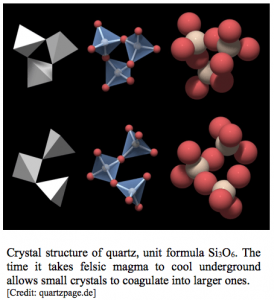 Quartz is the most abundant mineral crystal, comprising 12% of the Earth’s crust, and is often mixed in with other types of igneous, sedimentary, and metamorphic rock. Mineral hybrids containing crystals have been used around the world for art, science, and their believed healing properties for centuries. One such crystal is called diorite, and is often found with quartz intermixed, called quartz diorite. Catalina’s unique geology allows us to find quartz diorite along our cliffs and beaches. Quartz diorite was used in ancient Egypt for artistic sculptures, statues, and mausoleums.
Quartz is the most abundant mineral crystal, comprising 12% of the Earth’s crust, and is often mixed in with other types of igneous, sedimentary, and metamorphic rock. Mineral hybrids containing crystals have been used around the world for art, science, and their believed healing properties for centuries. One such crystal is called diorite, and is often found with quartz intermixed, called quartz diorite. Catalina’s unique geology allows us to find quartz diorite along our cliffs and beaches. Quartz diorite was used in ancient Egypt for artistic sculptures, statues, and mausoleums.
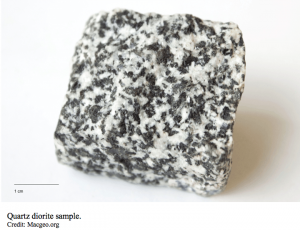
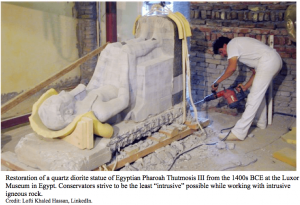
- Phew, that’s a lot of rockin’ slang! To learn about geological terms and what they mean, check out this awesome glossary: http://www.ge-at.iastate.edu/glossary-of-geologic-terms/
- To watch some cool animation of how subduction and volcanism work, check out http://earthguide.ucsd.edu/eoc/teachers/t_tectonics/p_subduction.html and https://www.classzone.com/books/earth_science/terc/content/visualizations/es0902/es0902page01.cfm?chapter_no=visualization
- For a better description for mafic vs. felsic rocks, check out this YouTube geologist: https://www.youtube.com/watch?v=50gJVmti9DE
- To explore some 3D crystal structures, check out the JMOL database*: http://www.webmineral.com/jmol/index.shtml#.V_ahu7wrJGE or the American Mineralogist Crystal Structure Database: http://rruff.geo.arizona.edu/AMS/amcsd.php *make sure you are using an updated browser with Java enabled
- To learn more about ancient sculpture and how modern preservationists use geology to preserve artifacts, check out the story of Thutmosis here: https://www.linkedin.com/pulse/20140712125313-131054088-conservation-of-the-quartz-diorite-statue-of-thutmosis-iii-luxor-museum-egypt-2003

